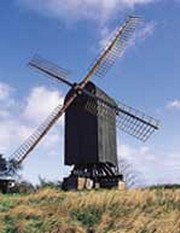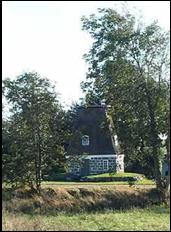Water Mills :
As a whole, mills have been known to exist in Denmark since around the year 400. The oldest ones were water mills, more precisely “Squat mills”.
This type of mill was driven by a small, horizontal wheel with oblique shovels, onto which the water felt. The wheel shaft was fixed on the upper mill stone (the runner).
A Squat Mill only had very limited power, and as a consequence, the grinding stones were quite small.
In the middle of the 11th century, the larger water mills started to appear in Denmark and little by little, they gained on the small squat mills. Normally, the water mills were used to pre-grind the grain.
They could have :
1. Drop wheels, where the water is running towards the back side of the wheel.
2. Upper wheels, where the water is led through a more or less closed backhoe to the middle of the upper side of the wheel. This way, both the speed and the weight of the water are used, which then falls on the wheel’s shovels.
The gain is therefore important.
Several Danish water mills still grind grain, for instance Tadre Mill by Kirke Hvalsø and Blåbæks Mill by Fakse.
 Stump Mills :
Stump Mills :
A stump mill is a type of wind mill where the mill house is placed on a vertical axe on a foot of hard lumber. When the mill is turned towards the wind, the whole house and the wings are turned. This was done from the ground with a crank.
Back then, the stump mills were the most common type of wind mill in Denmark. Now, there are only a few left, and some are still working, for instance Pibe Mill in the Northern part of Sealand.
Wind mills of the Dutch type :
On a Dutch wind mill, only the hat with the wings can be turned against the wind. This can be done either by turning by hand or with a crank. The mill then has a “svans”; a heavy beam construction hanging down from the hat.
 Another way to turn the wings is an automatic yaw where a wind rose on the hat makes the hat turn after the wind through an ingenious system of poles and cogs.
Another way to turn the wings is an automatic yaw where a wind rose on the hat makes the hat turn after the wind through an ingenious system of poles and cogs.
The hat with wings, which on a mill like Løve Mill weighs appr. 10 tons is placed loosely on a circular rail on top of the mill’s body. Therefore, it is very important that this kind of mills always stands in wind. Otherwise, the pressure from the wind can make the hat fall off!
There are 3 kinds of Dutch wind mils :
The Galeri Mill, which is the most common kind. The name comes from the fact that it has a gallery from where the miller could operate the mill, set sails, take off, start or stop the mill or turn it into the wind, if it wasn’t self-yawning. It had a drive-through port and was therefore quite high. For example, Løve Mølle measures 19 meters from the ground to the top of the hat.
 The Basement Mill, which stood on a large pile of earth or another type of foundation, through which the horse carriages could drive. One drove under the mill. A typical Basement Mill is for instance the Blåbæk Wind mill.
The Basement Mill, which stood on a large pile of earth or another type of foundation, through which the horse carriages could drive. One drove under the mill. A typical Basement Mill is for instance the Blåbæk Wind mill.
The Earth Mill, which was placed directly on the ground with no real ground building. All grain or flour had to be carried in and out of the mill. This mill is one of the smallest mills of the Dutch type. As an example, we have the Svalles Mølle by Svallerup.
As a whole, mills have been known to exist in Denmark since around the year 400. The oldest ones were water mills, more precisely “Squat mills”.
This type of mill was driven by a small, horizontal wheel with oblique shovels, onto which the water felt. The wheel shaft was fixed on the upper mill stone (the runner).
A Squat Mill only had very limited power, and as a consequence, the grinding stones were quite small.
In the middle of the 11th century, the larger water mills started to appear in Denmark and little by little, they gained on the small squat mills. Normally, the water mills were used to pre-
They could have :
1. Drop wheels, where the water is running towards the back side of the wheel.
2. Upper wheels, where the water is led through a more or less closed backhoe to the middle of the upper side of the wheel. This way, both the speed and the weight of the water are used, which then falls on the wheel’s shovels.
The gain is therefore important.
Several Danish water mills still grind grain, for instance Tadre Mill by Kirke Hvalsø and Blåbæks Mill by Fakse.
 Stump Mills :
Stump Mills : A stump mill is a type of wind mill where the mill house is placed on a vertical axe on a foot of hard lumber. When the mill is turned towards the wind, the whole house and the wings are turned. This was done from the ground with a crank.
Back then, the stump mills were the most common type of wind mill in Denmark. Now, there are only a few left, and some are still working, for instance Pibe Mill in the Northern part of Sealand.
Wind mills of the Dutch type :
On a Dutch wind mill, only the hat with the wings can be turned against the wind. This can be done either by turning by hand or with a crank. The mill then has a “svans”; a heavy beam construction hanging down from the hat.
 Another way to turn the wings is an automatic yaw where a wind rose on the hat makes the hat turn after the wind through an ingenious system of poles and cogs.
Another way to turn the wings is an automatic yaw where a wind rose on the hat makes the hat turn after the wind through an ingenious system of poles and cogs. The hat with wings, which on a mill like Løve Mill weighs appr. 10 tons is placed loosely on a circular rail on top of the mill’s body. Therefore, it is very important that this kind of mills always stands in wind. Otherwise, the pressure from the wind can make the hat fall off!
There are 3 kinds of Dutch wind mils :
The Galeri Mill, which is the most common kind. The name comes from the fact that it has a gallery from where the miller could operate the mill, set sails, take off, start or stop the mill or turn it into the wind, if it wasn’t self-
 The Basement Mill, which stood on a large pile of earth or another type of foundation, through which the horse carriages could drive. One drove under the mill. A typical Basement Mill is for instance the Blåbæk Wind mill.
The Basement Mill, which stood on a large pile of earth or another type of foundation, through which the horse carriages could drive. One drove under the mill. A typical Basement Mill is for instance the Blåbæk Wind mill. The Earth Mill, which was placed directly on the ground with no real ground building. All grain or flour had to be carried in and out of the mill. This mill is one of the smallest mills of the Dutch type. As an example, we have the Svalles Mølle by Svallerup.





